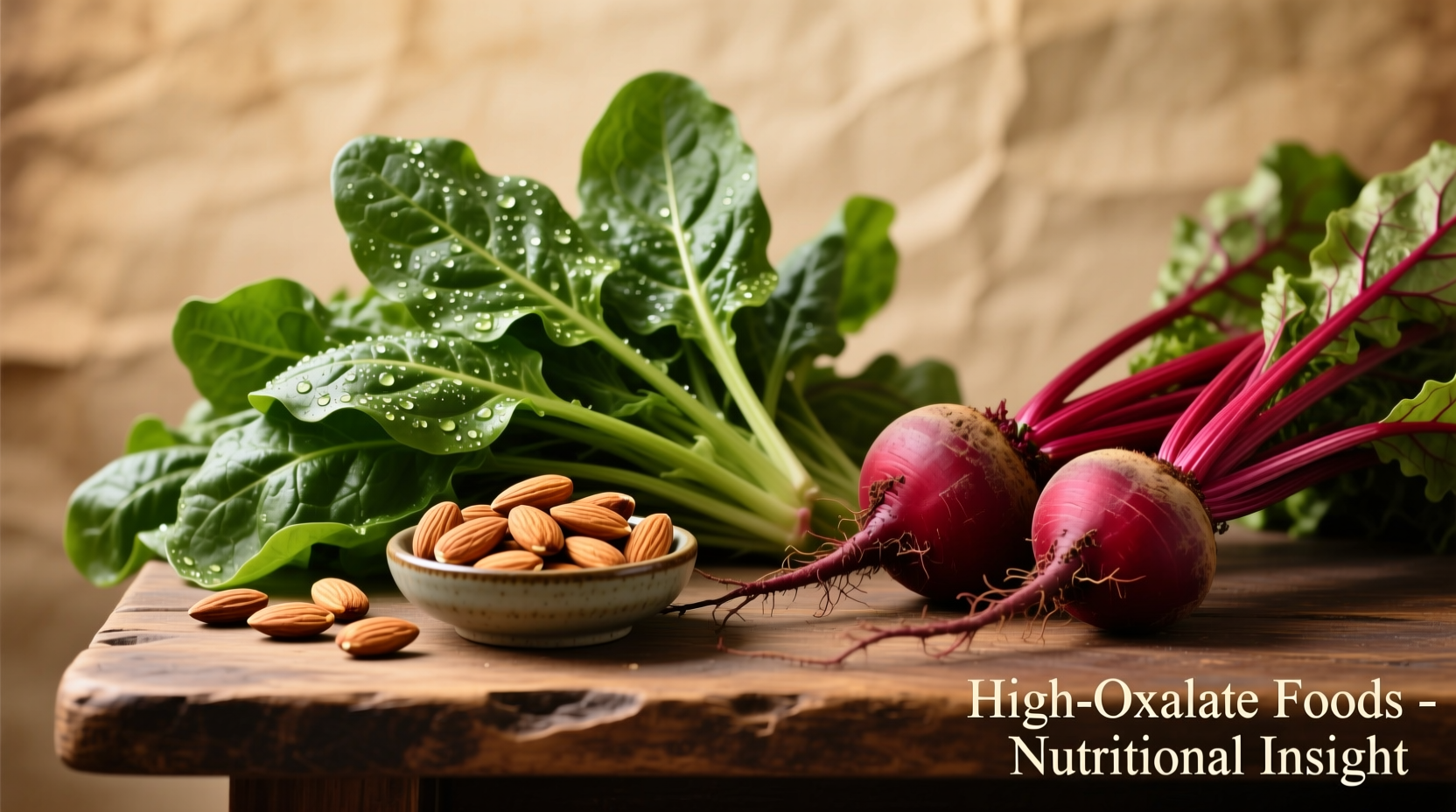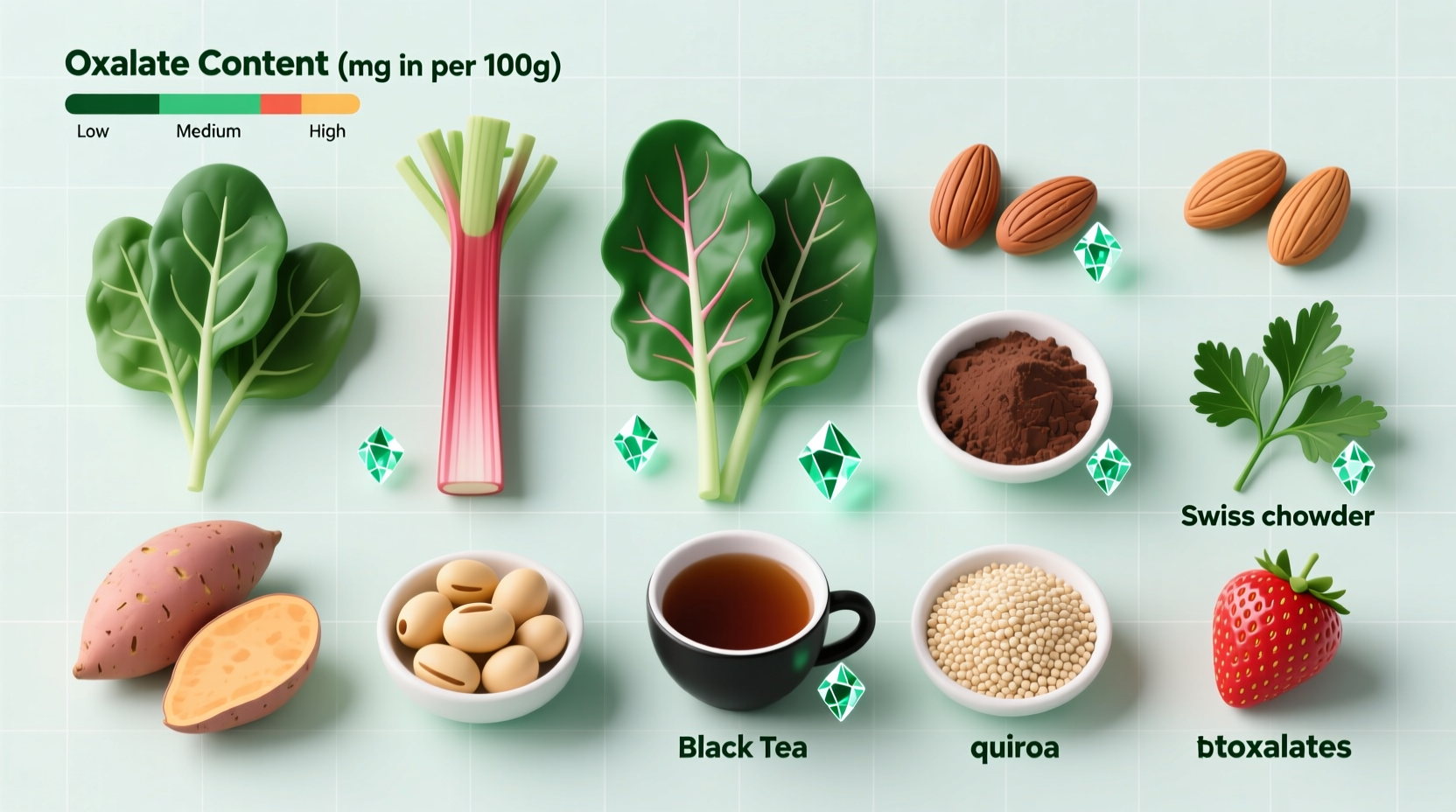If you're searching for what food has oxalate, the top high-oxalate foods include spinach (750-800mg per cup cooked), rhubarb (540mg per cup), beets (150mg per cup), almonds (122mg per ounce), and dark chocolate (up to 700mg per 100g). This comprehensive guide reveals exactly which foods contain significant oxalates, explains why it matters for certain health conditions, and provides practical strategies for managing your intake—whether you're concerned about kidney stones or optimizing nutrient absorption.
Understanding Oxalates: More Than Just a List
When you search for what food has oxalate, you're likely seeking practical dietary guidance—not just a random compilation. Oxalates are naturally occurring compounds found in many plant foods that can bind with calcium during digestion. For most people, these compounds pose no health risk and are simply eliminated through urine. However, individuals prone to calcium-oxalate kidney stones—which account for 80% of all kidney stones—need to carefully monitor their oxalate intake.
According to the National Kidney Foundation, consuming more than 250-300mg of oxalates daily may increase stone formation risk for susceptible individuals. The key isn't elimination but strategic management: pairing high-oxalate foods with calcium-rich options during meals helps bind oxalates in the gut before absorption.
High-Oxalate Foods by Category: What You Need to Know
Not all high-oxalate foods are created equal. The oxalate content varies significantly based on preparation methods, growing conditions, and plant varieties. Here's a breakdown of common foods organized by category with verified oxalate measurements from USDA and peer-reviewed research:
| Food Category | High-Oxalate Examples | Oxalate Content (per standard serving) | Context Notes |
|---|---|---|---|
| Leafy Greens | Spinach, Swiss chard, beet greens | Spinach: 750-800mg (1 cup cooked) | Cooking reduces soluble oxalates by 30-50% but concentrates insoluble forms |
| Vegetables | Rhubarb, beets, okra, sweet potatoes | Rhubarb: 540mg (1 cup cooked) | Beets contain moderate oxalates but high betalains with antioxidant benefits |
| Nuts & Seeds | Almonds, cashews, peanuts, sesame seeds | Almonds: 122mg (1 oz) | Soaking nuts reduces oxalate content by 15-20% |
| Fruits | Starfruit, blackberries, raspberries, figs | Blackberries: 40mg (1 cup) | Most fruits contain low-to-moderate oxalates; exceptions exist |
| Grains & Legumes | Soy products, wheat bran, quinoa, beans | Soybeans: 100mg (1 cup cooked) | Fermentation (like in tempeh) reduces oxalate content significantly |
| Beverages | Tea (especially black), cocoa, beet juice | Cocoa: 500-700mg (per 100g) | Brewing time affects tea oxalate levels; shorter steep = less oxalate |
Who Actually Needs to Limit Oxalates? Understanding Context Boundaries
Not everyone searching for what food has oxalate needs to restrict these compounds. The National Institutes of Health (NIH) clarifies that only specific populations should monitor oxalate intake:
- Individuals with a history of calcium-oxalate kidney stones (affecting 1 in 11 Americans)
- People with primary hyperoxaluria (a rare genetic disorder)
- Those with enteric hyperoxaluria (from malabsorption conditions like Crohn's disease)
For the general population, high-oxalate foods often provide valuable nutrients that shouldn't be avoided unnecessarily. Spinach, for example, delivers exceptional vitamin K, magnesium, and folate—benefits that typically outweigh oxalate concerns for healthy individuals. The American Dietetic Association emphasizes that blanket oxalate restriction without medical indication can lead to nutrient deficiencies.
Practical Strategies for Managing Oxalate Intake
If you're concerned about oxalates due to kidney stone risk or other health conditions, implement these evidence-based approaches:
Smart Pairing Techniques
Consume calcium-rich foods (dairy or fortified alternatives) simultaneously with high-oxalate foods. Research published in the Clinical Journal of the American Society of Nephrology shows this binding process in the digestive tract reduces oxalate absorption by 30-40%. Try adding cheese to spinach dishes or milk to your morning oatmeal.
Preparation Methods That Reduce Oxalates
Boiling high-oxalate vegetables and discarding the water removes 30-50% of soluble oxalates. Steaming or roasting preserves more nutrients but removes fewer oxalates. For nuts and seeds, soaking overnight followed by thorough rinsing can reduce oxalate content by 15-20%.
Hydration Is Your Best Defense
The Mayo Clinic recommends drinking enough fluids to produce at least 2.5 liters of urine daily—approximately 12 cups of water. This simple strategy dilutes urine concentration and significantly reduces stone formation risk, even with moderate oxalate consumption.

Common Misconceptions About Oxalates
Several myths persist about oxalates that can lead to unnecessary dietary restrictions:
- Myth: All oxalate-rich foods must be eliminated
Fact: Most kidney stone prevention protocols allow 100-150mg of oxalates per meal when paired with calcium - Myth: Cooking destroys all oxalates
Fact: Only boiling with water discard significantly reduces soluble oxalates; other methods have minimal impact - Myth: Oxalates cause kidney stones in everyone
Fact: Only 10-15% of oxalate in urine comes from dietary sources; the rest is produced internally
When to Consult a Professional
If you've experienced kidney stones or have specific health conditions, work with a registered dietitian specializing in renal nutrition. They can provide personalized guidance based on your 24-hour urine test results—the gold standard for determining your individual oxalate excretion rate. The National Kidney Foundation offers a provider directory for locating qualified specialists.
Frequently Asked Questions
Does cooking reduce oxalates in vegetables?
Boiling vegetables and discarding the water reduces soluble oxalates by 30-50%, but steaming, roasting, or sautéing has minimal effect on oxalate content. The insoluble oxalate fraction remains largely unchanged regardless of cooking method.
Are all nuts high in oxalates?
Most nuts contain moderate to high oxalates, with almonds and cashews being particularly high. Walnuts and pecans contain lower amounts. Soaking nuts overnight and rinsing thoroughly before consumption can reduce oxalate content by approximately 15-20%.
Can I eat spinach if I'm concerned about oxalates?
Yes, but strategically. Pair spinach with calcium-rich foods like cheese or yogurt to bind oxalates during digestion. Limit portions to ½ cup cooked per meal, and rotate with low-oxalate greens like kale or cabbage to maintain dietary variety while managing intake.
What's the difference between soluble and insoluble oxalates?
Soluble oxalates dissolve in water and are more readily absorbed by the body, contributing to kidney stone risk. Insoluble oxalates pass through the digestive system with minimal absorption. Boiling removes soluble oxalates but leaves insoluble forms intact.











 浙公网安备
33010002000092号
浙公网安备
33010002000092号 浙B2-20120091-4
浙B2-20120091-4